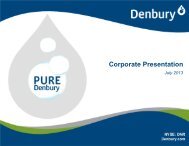Interactive 2009 Annual Report (PDF 7.56 MB) - Denbury Resources ...
Interactive 2009 Annual Report (PDF 7.56 MB) - Denbury Resources ...
Interactive 2009 Annual Report (PDF 7.56 MB) - Denbury Resources ...
- No tags were found...
You also want an ePaper? Increase the reach of your titles
YUMPU automatically turns print PDFs into web optimized ePapers that Google loves.
94 <strong>Denbury</strong> <strong>Resources</strong> Inc. <strong>2009</strong> <strong>Annual</strong> <strong>Report</strong>Note 9. Stock Compensation PlansStock Incentive Plans<strong>Denbury</strong> has two stock compensation plans. The first plan has been in existence since 1995 (the “1995 Plan”) andexpired in August 2005 (although options granted under the 1995 Plan prior to that time can remain outstanding for up to10 years). The 1995 Plan only provided for the issuance of stock options, and in January 2005, we issued stock optionsunder the 1995 Plan that utilized substantially all of the remaining authorized shares. The second plan, the 2004 OmnibusStock and Incentive Plan (the “2004 Plan”), has a 10-year term and was approved by the stockholders in May 2004. InMay 2007, shareholders approved an increase to the number of shares that may be used under our 2004 Plan, from 10.0million to 14.0 million shares. In May <strong>2009</strong>, the shareholders approved an additional increase from 14.0 million to 21.5 millionshares. The 2004 Plan provides for the issuance of incentive and non-qualified stock options, restricted stock awards,stock appreciation rights (“SARs”) settled in stock, and performance awards that may be issued to officers, employees,directors and consultants. Awards covering a total of 21.5 million shares of common stock are authorized for issuancepursuant to the 2004 Plan, of which awards covering no more than 14.2 million shares may be issued in the form ofrestricted stock or performance vesting awards. At December 31, <strong>2009</strong>, a total of 7,565,963 shares were available for futureissuance of awards, of which only 7,348,042 shares may be in the form of restricted stock or performance vesting awards.<strong>Denbury</strong> has historically granted incentive and non-qualified stock options to its employees. Effective January 1,2006, we completely replaced the use of stock options for employees with SARs settled in stock, as SARs are lessdilutive to our stockholders while providing an employee with essentially the same economic benefits as stock options.The stock options and SARs generally become exercisable over a four-year vesting period with the specific terms ofvesting determined at the time of grant based on guidelines established by the Board of Directors. The stock optionsand SARs expire over terms not to exceed 10 years from the date of grant, 90 days after termination of employment,and 90 days or one year after permanent disability, depending on the plan, or one year after the death of the optionee.The stock options and SARs are granted at the fair market value at the time of grant, which is defined in the 2004Plan as the closing price on the NYSE on the date of grant. The plan is administered by the Compensation Committeeof <strong>Denbury</strong>’s Board of Directors.In 2004, <strong>Denbury</strong> began the use of restricted stock awards for its officers and independent directors, all grantedunder the 2004 Plan. The holders of these shares have all of the rights and privileges of owning the shares (includingvoting rights) except that the holders are not entitled to delivery of a portion thereof until certain requirements are met.With respect to the restricted stock granted to officers of <strong>Denbury</strong> in 2004, the vesting restrictions on those shares areas follows: i) 65% of the awards vest 20% per year over five years, and ii) 35% of the awards vest upon retirement, asdefined in the 2004 Plan. On January 30, <strong>2009</strong>, the Board of Directors modified the vesting provisions for the 35% ofthe awards that would vest upon retirement to now vest ratably each January 31 (beginning January 31, <strong>2009</strong>) untilthe final vesting on the retirement eligibility date.Total stock-based compensation expense was $21.9 million, $14.1 million and $10.6 million for the years endedDecember 31, <strong>2009</strong>, 2008 and 2007, respectively. Part of this expense, $1.4 million in <strong>2009</strong>, $1.4 million in 2008 and$1.5 million in 2007, was included in “Lease operating expenses” for stock compensation expense associated with ourfield employees, and the remaining amount recognized in “General and administrative expenses” in the ConsolidatedStatements of Operations. The total income tax benefit recognized in the Consolidated Statements of Operations forshare-based compensation arrangements was $8.7 million, $5.3 million and $4.1 million for the years ended December31, <strong>2009</strong>, 2008 and 2007, respectively. Share-based compensation associated with our employees involved in explorationand drilling activities of $2.5 million, $2.2 million and $1.6 million for the years ended December 31, <strong>2009</strong>, 2008 and 2007,respectively, has been capitalized as part of “Oil and natural gas properties” in the Consolidated Balance Sheets.Stock Options and SARsThe fair value of each SAR award is estimated on the date of grant using the Black-Scholes option pricing modelwith the assumptions noted in the following table. The risk-free rate for periods within the contractual life of the option isbased on the U.S. Treasury yield curve in effect at the time of grant. The expected life of stock options and SARsgranted was derived from examination of our historical option grants and subsequent exercises. The contractual terms(4-year cliff vesting and 4-year graded vesting) are evaluated separately for the expected life, as the exercise behaviorForm 10-K Part IINotes to Consolidated Financial Statements




